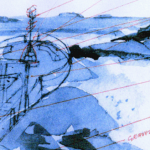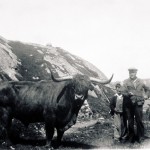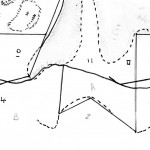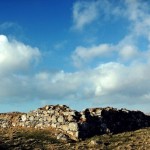Category: Land Issues
Congested Bulls
Old Mangersta
Clearances 1851
Amhran Lord Lever, le Domhnall Donn
Kelp Harvesting
The Airigh Trail, again
Lot 18: Uig Crofters
On the Lewis-Harris Boundary
The Clearance of Vuia Mhòr
Mealista v. Ardroil
By long and solid tradition in Uig, the spot where the Uig Chessmen were found in 1831 is held to be the Bealach Ban, a hollow in the dunes in Ardroil. In November of last year, a paper by Dr David Caldwell et al in Mediæval Archaeology proposed that, on the evidence of the Ordnance Survey Place Names book compiled by contractors from local information in the 1850s, the findspot may have been a few miles away at Mealista. Anna Mackinnon, Ardroil, wrote an initial response countering that suggestion and gives more evidence from the Place Names book here. This piece appeared earlier this month in the Uig News; thanks to Anna and the Uig News for the opportunity to republish it. Meanwhile Dr Caldwell will be speaking in Uig about the Chessmen on Thursday 4 March. Further detail will follow.
Over the last few weeks, I’ve been delving into the book of place names collected by the very first Ordnance Survey of the 1850s to find out for myself what’s actually there and to work out how much import can be given to the entry that states that the Chessmen were found in Mealista, in the ruins of Taigh nan Cailleachan Dubha. The Place Names book is easily accessible, on microfiche in the Stornoway Library.
I have to say that it’s an example of meticulous paperwork, a colossal amount of painstaking effort must have gone into its compilation but to the 21st century eye, it looks fussy and overdone. It’s handwritten and ruled out in column after column: place name; its correct spelling; any other known variation of the spelling; the location; the English “significance” i.e. translation of the name; the names of the person or persons who were the authorities for the information and of the Ordnance Survey Clerks who wrote it all down and, finally, a column for comments.
We used to be advised as students not to use it as a reliable source as the information was only as good as the knowledge of the informant and also, because its accuracy could have been compromised in translation. There’s a long time since I last looked at it and this time round, I found its main impact, apart from its painstaking “clerkery,” was the sheer volume of place names in the parish of Uig. Going through the pages nearer home, I felt as if I was meeting old friends as place names jumped out at me from the screen, names I used to hear in daily conversation, which are now rarely, if ever, aired.
I was also intrigued by the names of the local informants of the 1850s. I would really like to go back to it and list them all down to see how many can be identified with the help of the census returns. I found my great, great grandfather, Murdo Macleod, Gisla, (Murchadh Ghioslaigh) and his neighbour and brother-in-law, John Macdonald, (Iain Laghach) reeling off names. That pinpoints the collecting of place names to before 1853 and the Gisla clearance, after which all the Laghach family but two ended up in Quebec.
From memory, I was sure that the Chessmen were noted in the pages relating to the Ardroil area although the name Ardroil wasn’t in use in its present form as early as the 1850s. The farm was known initially by variations of Eadar Dha Fhadhail, such as Ederol. The entry about Chessmen is there, under the place name “Bealach Ban.” It reads, “A glen on the south side of Camus Uig, it is composed of sand. A few years back a number of carved Ivory images of horses, sheep and other animals were found in this glen. Signifies white glen or pass.”
The Minister We Never Had
Scramble for Rural Houses (1949)
“The wanderlust of the Uigeach”, from the Stornoway Gazette, 30 December 1949.
Swedish timber houses allocated to West Uig are not to be built there. Owing to the depopulation of the district there is very little chance of finding tenants. When this news was given to the Lewis District Council by the chairman, Councillor John Maciver, there was a scramble by the other districts in the island to claim the houses. The houses had originally been allocated to West Uig in the hope that they would help to arrest depopulation, but it was not likely that they would ever find tenants for twenty houses in Uig, he said.
Rather than lose the twenty houses, he thought they should try to get them for some other district in rural Lewis. He recognised the congestion around Stornoway, with people coming in to find work in the mills, but he wanted ten of the houses for Shawbost, and he understood Councillor Donald Macleod wanted ten for Point. For the last four houses at Springfield, there were over 100 applications, but only nine of these had come from outside the burgh, although the houses were intended for Point, Back and the central ward of Stornoway.
“Where do you want these houses to go?” he asked.
“I think Councillor Duncan Maciver and I have the first say in that,” said Councillor Smith, Uig. “I think they should be erected near Stornoway, and priority should be given to the people of Uig when they’re finished, as the people of Uig had been chased out of Uig by the County Council and partly by the Lewis District Council. Today we haven’t got the young men and young women left there to occupy them. If they get married they have to go and live on the mainland.”
Councillor Smith went on to say the conditions under which they had to live were a disgrace to humanity, and he made a vigorous attack on the authorities for the neglect of the road.
“It is not my fault. I did my best to get you twenty houses in Uig. It was hoped it would arrest the depopulation, but there’s always a wanderlust in the Uigeach,” said the chairman.
The Rose
Crofting at the Upper End, 1958-9
The Uig Quiz
Prosperity and Overcrowding in Uig, 1850s-1890s
Donald Òg Macaulay of Brenish, Part I
Norman Morrison’s Testimony
On 4 June 1883 the Napier Commission, chaired by Lord Napier, was in Miavaig to take evidence from crofters and others on issues surround land management and tenancy. Among those interviewed was Norman Morrison, crofter and fisherman at Brenish, aged 61, who stated he had two milk cows, three young beasts, between fifteen and twenty sheep, and no horse, on a croft which he shared with his brother, who kept similar stock. The following is slightly abridged.
Have you been fairly elected a delgate by the people of Brenish? Yes
How many people were present when you were elected? All the male population of the town.
Have you any statement to make on behalf of the people? I would say, in the first place, that they are crowded so much together that they have no way of living. Our places were crowded first when the neighbouring township of Mealista was cleared [in 1838]. Six families of that township were thrown in among us; the rest were hounded away to Australia and America, and I think I hear the cry of the children till this day. There were others came from various townships since at different times as these were being cleared, and I instance various examples – one from one place and one from another – and not one was placed in among us in that way, but accommodation was provided for him by subdividing the lots that were in the place. We were deprived of the old rights of the township moorland pasture. The half of the island of Mealista belong in the time of my grandfather to our township and a neighbouring township – we were deprived of that. We got no abatement of rent when we were deprived of that but when Cameron lotted out the township the rent was increased by £30.
As you are sixty-one years of age, can you perhaps remember how many families there were in Brenish before the township was cleared and the people taken to Brenish? Between twelve and sixteen.
How many are there now? Forty-three.
How many of those are crofters paying rent to the proprietor? There are twenty-nine names on the rent roll.
And the rest are cottars? There are some of them who pay from 5s to 10s.
Then the number of the families has increased from sixteen to forty-three. How many of that number do you think have come in from the outside and how many are the natural increase of the place? Seven came from the outside. We also consider we have a grievance with respect to the herd of the march. It is fourteen years since a herd was set apart for ourselves and the neighbouring tacksman, and we are quite willing to pay the half of the wages of that shepherd, but we have always had the idea that the neighbouring tacksman marching with us ought to pay the other half. We are also complaining about the dyke that was build about thirty-four years ago. It was built in the time of the destitution, and the people were paid for the building of it by so much Indian meal. Four shillings or five shillings additional rent was placed upone every one that was on the rent roll at that date for this dyke, and we were under the impression that when the expense of putting up the fence was paid this 4s or 5s would be taken away.





